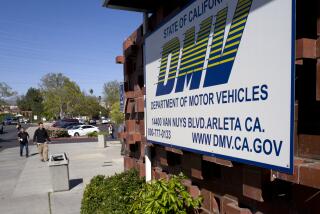Older Drivers Are Reconditioning Their Skills : Seniors Cut Insurance Cost by Learning How to Handle a Car All Over Again
- Share via
June Price said she learned to drive on her parents’ Northern California ranch “not too long after I learned to walk.”
She was typical of rural youngsters of the prewar era who piloted farm machinery or ran errands in those old, boat-like Hudsons, years before they went on their first date.
But now, at age 58, Price figured it was time she took a driver-education course.
So, for six hours on two recent weekday mornings, the La Mirada bookkeeper sat in a small classroom at the Buena Park Senior Center with 38 other veteran drivers and learned to handle a car all over again.
Different Incentive
This time, however, there was a different incentive: money.
Price and the other students, all 55 years and older, were sharpening their driving skills and lowering their auto insurance premiums at the same time as part of the 55 Alive/Mature Driving program, sponsored by the American Assn. of Retired Persons. The first course of its kind offered nationwide, 55 Alive is designed to help mature drivers, whose reactions, vision and hearing may have diminished with age, to adapt their driving to their changing physiology, said John Fiscus, a volunteer instructor.
And, he added, three national insurance companies--The Hartford, Colonial Penn and Geico--offer 10% discounts on their auto insurance premiums to any senior who completes the 55 Alive course.
An even wider acceptance of the course by insurance companies will occur after the expected implementation of California Assembly Bill 2610, which would require all companies that insure California motorists to offer a premium reduction to older drivers who pass the 55 Alive course.
The bill, introduced in January by Assemblyman Richard Katz (D-Sepulveda), would authorize seniors who were issued a certificate after successful completion of the 55 Alive course to claim “an appropriate reduction” on their premiums. The certificate would be valid for three years, at which time the holder could take a refresher 55 Alive course.
Under the bill’s provisions, the discount could be revoked by the insurance companies if the motorist was at fault in a traffic accident or was found guilty of a major violation such as driving under the influence of alcohol or drugs.
The bill, which is awaiting Gov. Deukmejian’s signature, would go into effect Jan 1.
“If you look at the statistics of accidents per miles driven,” Katz said, “the oldest drivers and the youngest drivers have radically high accident rates. And there are lots of driving courses for younger people, but almost nothing for older people. If someone is 55 years of age and got a license, say, 45 years ago, they probably didn’t take a driving test or go to a driving school or take driver’s training classes like many of us did. The laws were different.”
Widespread insurance discounts, Katz said, would act as an incentive for seniors to take the 55 Alive course. A set discount percentage was not included in the bill because of pressure from insurance lobbies, he said, but added that he hoped the companies would specify discounts “in the 10% to 15% range.”
Reaction among the insurance companies to the bill has been “neutral,” Katz said.
Of the likelihood of Gov. Deukmejian signing the bill, Katz said he thought the governor “would be hard-pressed not to sign it.
“It’s a good bill,” said Katz, who added that it had passed both the Assembly and Senate by wide margins.
For instructor John Fiscus, the 55 Alive course is a way to acquaint seniors not only with driving laws and techniques they may have never formally learned but with the concessions they must make to their age when handling a car.
Physical Changes
The classes, which cost $7, are divided into six one-hour sessions spread evenly over two days. In addition to a course overview at the beginning and a wrap-up session at the end, the classes include instruction in physical changes in older drivers, interacting with traffic, accident prevention, and driving under adverse conditions.
Generally offered at city senior centers, the 55 Alive classes are taught about once a month in various areas throughout California.
There is little or no modesty about age among the students, and Fiscus occasionally twits them about it.
“I’m sure all of you think you react and see the same way today as you did when you were 21,” he said during the first class session. He then put his hand to his ear, cocked his head toward the class and said, “What’s that you say?”
Fiscus, a retired teacher who lives in La Habra, is energetic and active at age 75, but remains realistic about the effect advancing years have on driving. He is quick to point out that the often-misquoted statistic that holds that drivers over age 55 are safer than younger drivers is a false one.
While drivers 55 and over have fewer total accidents than those from age 25 to 54, Fiscus said, the younger drivers annually drive an average of 15,000 miles compared to 9,000 miles for the older drivers. Consequently, he said, older drivers actually have more accidents per miles driven than their younger counterparts.
“Older people don’t have to go nearly as far to get into trouble,” Fiscus said. “We want to build their confidence but we also want them to realize that they can have accidents, too.”
Fiscus also says he believes that qualified seniors should do all they can to retain their drivers licenses.
“If you lose your driving privilege you lose your independence,” he said. “My father lost his license at age 85 and went right downhill and died soon after that. He lost his mobility because he couldn’t parallel park.”
Such an elementary driving skill, Fiscus said, is not beyond the ability of most senior drivers, but it is a maneuver, among many others, that can be affected by the physiology of aging.
Bodily Changes
“For instance,” he said, “when they’re parallel parking or backing or changing lanes, maybe older persons aren’t so inclined to look over their shoulder because their arthritis is bothering them. Or maybe they’re having a hard time adjusting to a new pair of bifocals or they can’t see as well at night.”
The principal aim of the course, Fiscus said, is to integrate such bodily changes into everyday driving habits, “to change their attitude toward driving so they’ll become some of the best defensive drivers in Southern California. And several people do say the course improves their attitude, although I think most of them originally had it in mind to take the course for insurance purposes.”
That’s why Phil Guckes and his wife, Dorothy, drove to Buena Park from their home in Palm Desert to attend the class.
“My insurance was coming due,” Guckes said, “and I heard about the class, so we decided to come because it was the closest one to our home. We’re thinking of trying to set one up in our area now.”
Guckes, who said he had taken several defensive driving classes when he worked as an equipment repairman for Pacific Bell, called 55 Alive “a good refresher course. It points out some of the shortcomings I know are beginning to show up. My mind still tells me I’m in my 20s, but my body says I’m 64.”
Volunteer Instructor
Eleanor Hoover, 64, a retired elementary school teacher from Garden Grove, took the 55 Alive course in June and decided to become a volunteer instructor. She assisted Fiscus with the Buena Park class.
“The course just made me more confident,” she said. “It reinforced my idea that I was actually doing pretty well with my driving.”
“Those who want to be conscientious will get a lot out of the course,” Fiscus said. “Even those who are in it for the insurance, if we can get them to practice even a couple of the things they learn, they’ll be safer drivers.”
After all, he said, “we want to live as long as we possibly can. I don’t like the alternative to getting older.”
More to Read
Sign up for Essential California
The most important California stories and recommendations in your inbox every morning.
You may occasionally receive promotional content from the Los Angeles Times.










